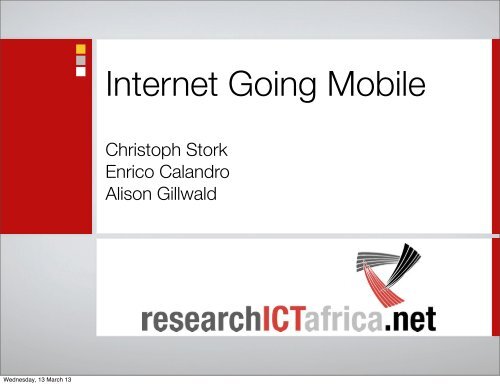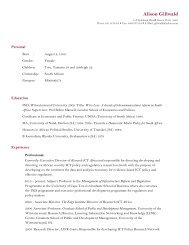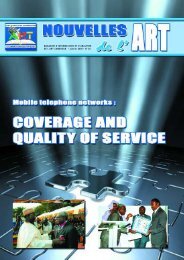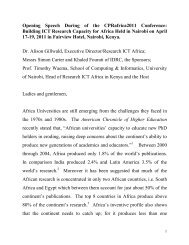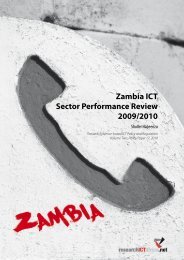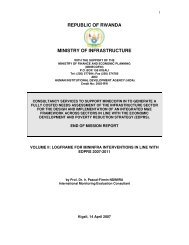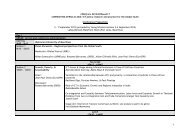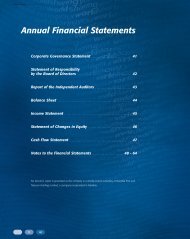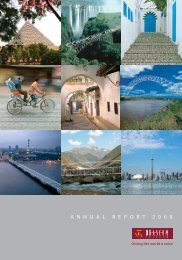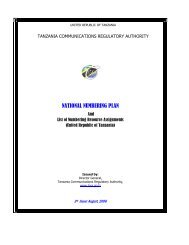2012 Stork Calandro Gillwald - Internet Going Mobile
2012 Stork Calandro Gillwald - Internet Going Mobile
2012 Stork Calandro Gillwald - Internet Going Mobile
Create successful ePaper yourself
Turn your PDF publications into a flip-book with our unique Google optimized e-Paper software.
<strong>Internet</strong> <strong>Going</strong> <strong>Mobile</strong><br />
Christoph <strong>Stork</strong><br />
Enrico <strong>Calandro</strong><br />
Alison <strong>Gillwald</strong><br />
Wednesday, 13 March 13
Sampling<br />
Step 1: Split Enumerator Areas into Urban and<br />
Rural EAs (Census Sample Frame of NSO)<br />
Step 2: PPS Sampling of EAs<br />
Step 3: Simple Random Sampling of Households<br />
through Listing<br />
Step 4: Simple Random Sampling of Household<br />
Members (Birthday method)<br />
Wednesday, 13 March 13
Wednesday, 13 March 13
Wednesday, 13 March 13
GPS Cameras to verify boundaries of EAs<br />
Wednesday, 13 March 13
Wednesday, 13 March 13
Listing Nigeria<br />
Structure<br />
IDs are<br />
part of<br />
the listing<br />
Wednesday, 13 March 13
Sample Size: UNSD<br />
Desired level of accuracy typically confidence level of 95%<br />
Absolute precision (relative margin of error) typically 5%.<br />
Population proportion P conservatively would be 0.5 (yields the largest<br />
sample size)<br />
⎛⎛<br />
n = Z p(1− p) ⎞⎞<br />
a<br />
⎜⎜<br />
⎟⎟<br />
⎝⎝<br />
⎠⎠<br />
C p<br />
2<br />
n =<br />
⎛⎛<br />
⎜⎜<br />
⎝⎝<br />
1.96 0.5(1 − 0.5)<br />
0.05<br />
⎞⎞<br />
⎟⎟<br />
⎠⎠<br />
2<br />
= 384<br />
Wednesday, 13 March 13
Country Target sample Actual sample<br />
1 Cameroon 1,200 1,200<br />
2 Ethiopia 1,600 1,608<br />
3 Ghana 1,200 1,203<br />
4 Kenya 1,200 1,239<br />
5 Nigeria 1,600 1,552<br />
6 Rwanda 1,200 1,200<br />
7 Tanzania 1,200 1,201<br />
8 Uganda 1,200 1,200<br />
9 Namibia 900 967<br />
10 South Africa 1,600 1,589<br />
11 Mozambique 1,200 1,199<br />
12 Botswana 900 919<br />
Total 15,000 15,077<br />
Wednesday, 13 March 13
HHw = household weight<br />
INDw = Individual weight 16+<br />
PHH = Household Selection Probability<br />
PEA = EA Selection Probability<br />
PI = Individual Selection Probability<br />
P HH<br />
=<br />
N<br />
HHw = DW *<br />
1<br />
P HH<br />
* P EA<br />
P EA<br />
= m *<br />
HH EA<br />
HH EA<br />
HH STRATA<br />
€<br />
INDw = DW *<br />
1<br />
€<br />
P HH<br />
* P EA<br />
* P I<br />
P I<br />
=<br />
1<br />
HH m16+<br />
€<br />
€<br />
Wednesday, 13 March 13
Household Access and Usage<br />
Wednesday, 13 March 13
Percentage of households with electricity still very low<br />
in many African countries, some even saw a decline<br />
2007/8 2011/12<br />
89%<br />
73%<br />
77%<br />
58%<br />
60%<br />
60%<br />
57%<br />
65%<br />
63%<br />
45%<br />
42%<br />
48%<br />
47%<br />
13%<br />
10%<br />
5%<br />
16%<br />
18%<br />
13%<br />
19%<br />
Uganda<br />
Rwanda<br />
Ethiopia<br />
Tanzania<br />
Namibia<br />
Nigeria<br />
Botswana<br />
Kenya<br />
Cameroon<br />
Ghana<br />
South Africa<br />
Wednesday, 13 March 13
Radio still main source of information<br />
TV luxury good in several countries<br />
Households with Radio<br />
Households with TV<br />
Kenya<br />
81%<br />
South Africa<br />
78%<br />
Uganda<br />
77%<br />
Botswana<br />
59%<br />
Rwanda<br />
72%<br />
Kenya<br />
54%<br />
Namibia<br />
72%<br />
Ghana<br />
54%<br />
Ghana<br />
72%<br />
Nigeria<br />
53%<br />
Nigeria<br />
70%<br />
Cameroon<br />
44%<br />
Botswana<br />
66%<br />
Namibia<br />
41%<br />
Tanzania<br />
63%<br />
Tanzania<br />
18%<br />
South Africa<br />
62%<br />
Uganda<br />
13%<br />
Ethiopia<br />
41%<br />
Ethiopia<br />
10%<br />
Cameroon 34%<br />
Rwanda 9%<br />
Wednesday, 13 March 13
Share of households with fixed-lines<br />
2007/8 2011/12<br />
South Africa<br />
Namibia<br />
11.5%<br />
18.2%<br />
18.0%<br />
17.4%<br />
Botswana<br />
11.0%<br />
15.0%<br />
Ethiopia<br />
4.0%<br />
7.6%<br />
Ghana<br />
Kenya<br />
0.6%<br />
2.6%<br />
1.8%<br />
2.3%<br />
Cameroon<br />
Tanzania<br />
Uganda<br />
Rwanda<br />
Nigeria<br />
1.8%<br />
2.2%<br />
0.9%<br />
0.4%<br />
0.3%<br />
1.5%<br />
0.1%<br />
0.2%<br />
0.3%<br />
Fixed-lines on the way out<br />
except Botswana,<br />
Cameroon, Uganda and<br />
Rwanda<br />
Wednesday, 13 March 13
Share of households with a<br />
working computer<br />
Share of households with a<br />
working <strong>Internet</strong> connection<br />
South Africa<br />
24.5%<br />
South Africa<br />
19.7%<br />
Botswana<br />
15.7%<br />
Kenya<br />
12.7%<br />
Namibia<br />
14.7%<br />
Namibia<br />
11.5%<br />
Kenya<br />
12.7%<br />
Botswana<br />
8.6%<br />
Cameroon<br />
8.6%<br />
Nigeria<br />
3.4%<br />
Ghana<br />
8.5%<br />
Ghana<br />
2.7%<br />
Nigeria<br />
6.6%<br />
Cameroon<br />
1.3%<br />
Uganda<br />
2.2%<br />
Uganda<br />
0.9%<br />
Rwanda<br />
2.0%<br />
Tanzania<br />
0.8%<br />
Tanzania<br />
1.6%<br />
Rwanda<br />
0.7%<br />
Ethiopia 0.7%<br />
Ethiopia 0.5%<br />
Less than a quarter of households have a computer and even<br />
fewer <strong>Internet</strong> access<br />
Wednesday, 13 March 13
Individual Access and Usage<br />
Wednesday, 13 March 13
15+ Owning a mobile<br />
Share of those with a mobile that<br />
own one that is capable of browsing<br />
the <strong>Internet</strong><br />
South Africa<br />
84%<br />
South Africa<br />
51%<br />
Botswana<br />
80%<br />
Kenya<br />
32%<br />
Kenya<br />
74%<br />
Namibia<br />
31%<br />
Nigeria<br />
66%<br />
Botswana<br />
30%<br />
Ghana<br />
60%<br />
Ghana<br />
29%<br />
Namibia<br />
56%<br />
Nigeria<br />
23%<br />
Uganda<br />
47%<br />
Tanzania<br />
19%<br />
Cameroon<br />
45%<br />
Rwanda<br />
19%<br />
Tanzania<br />
36%<br />
Uganda<br />
15%<br />
Rwanda<br />
24%<br />
Cameroon<br />
15%<br />
Ethiopia 18%<br />
Ethiopia 7%<br />
Wednesday, 13 March 13
Using mobile to browse the <strong>Internet</strong><br />
South Africa<br />
Kenya<br />
Namibia<br />
Botswana<br />
Nigeria<br />
Rwanda<br />
Ghana<br />
Cameroon<br />
8%<br />
Uganda<br />
8%<br />
Tanzania 5%<br />
Ethiopia 5%<br />
15%<br />
13%<br />
16%<br />
25%<br />
24%<br />
23%<br />
28%<br />
Using mobile for Facebook etc.<br />
South Africa<br />
Kenya<br />
Botswana<br />
18%<br />
Namibia<br />
17%<br />
Nigeria<br />
16%<br />
Rwanda<br />
14%<br />
Ghana<br />
11%<br />
Cameroon<br />
8%<br />
Uganda 7%<br />
Tanzania 5%<br />
Ethiopia 2%<br />
Wednesday, 13 March 13<br />
25%<br />
25%<br />
<strong>Internet</strong> use among<br />
mobile phone owners:<br />
Social networking more<br />
popular than email in<br />
some countries<br />
Using mobile for emailing<br />
South Africa<br />
Kenya<br />
Botswana<br />
Namibia<br />
Nigeria<br />
Rwanda<br />
Ghana<br />
10%<br />
Cameroon 4%<br />
Uganda<br />
6%<br />
Tanzania<br />
5%<br />
Ethiopia 10%<br />
12%<br />
13%<br />
15%<br />
17%<br />
17%<br />
20%
ITU data: Percentage of individuals using the <strong>Internet</strong><br />
!30!!<br />
!25!!<br />
!20!!<br />
Botswana!<br />
Ethiopia!<br />
Kenya!<br />
Namibia!<br />
Rwanda!<br />
Tanzania!<br />
Cameroon!<br />
Ghana!<br />
Mozambique!<br />
Nigeria!<br />
South!Africa!<br />
Uganda!<br />
!15!!<br />
!10!!<br />
!5!!<br />
!"!!<br />
1996! 1997! 1998! 1999! 2000! 2001! 2002! 2003! 2004! 2005! 2006! 2007! 2008! 2009! 2010!<br />
Wednesday, 13 March 13
2007/8 2011/12<br />
Ethiopia<br />
1%<br />
3%<br />
<strong>Internet</strong><br />
Tanzania<br />
2%<br />
4%<br />
use (15+)<br />
Rwanda<br />
2%<br />
6%<br />
more than<br />
doubled<br />
Uganda<br />
2%<br />
8%<br />
within 4<br />
Ghana<br />
6%<br />
13%<br />
years<br />
Cameroon<br />
13%<br />
14%<br />
Namibia<br />
9%<br />
16%<br />
Nigeria<br />
18%<br />
Kenya<br />
15%<br />
26%<br />
Botswana<br />
6%<br />
29%<br />
South Africa 15%<br />
34%<br />
Wednesday, 13 March 13
<strong>Internet</strong> Access Models<br />
Hardware<br />
Billing<br />
Skill requirement<br />
Electricity<br />
Location<br />
Old <strong>Internet</strong><br />
Computer / Laptop<br />
Postpaid (monthly <strong>Internet</strong><br />
subscription)<br />
High<br />
(Windows + <strong>Internet</strong> explorer +<br />
Viruses)<br />
electricity mostly required at<br />
location of <strong>Internet</strong> use<br />
Work, school, <strong>Internet</strong> cafe<br />
New <strong>Internet</strong><br />
<strong>Mobile</strong><br />
Prepaid<br />
Low<br />
no required at home<br />
Anywhere<br />
Wednesday, 13 March 13
Daily <strong>Internet</strong> use increased in past 4 years<br />
South Africa<br />
56%<br />
64%<br />
Kenya<br />
Namibia<br />
41%<br />
35%<br />
53%<br />
59%<br />
Ghana<br />
32%<br />
43%<br />
Botswana<br />
31%<br />
55%<br />
Tanzania<br />
Ethiopia<br />
19%<br />
15%<br />
47%<br />
52%<br />
Uganda<br />
Nigeria<br />
15%<br />
13%<br />
28%<br />
34%<br />
Rwanda 11%<br />
Cameroon 11% 19%<br />
57%<br />
2007/8<br />
2011/12<br />
Wednesday, 13 March 13
Where was the <strong>Internet</strong> used first?<br />
Computer<br />
<strong>Mobile</strong> phone<br />
Cameroon<br />
Rwanda<br />
Botswana<br />
Ghana<br />
Kenya<br />
South Africa<br />
Namibia<br />
Tanzania<br />
Nigeria<br />
Ethiopia<br />
82.1%<br />
70.8%<br />
70.6%<br />
70.5%<br />
68.9%<br />
65.1%<br />
50.1%<br />
45.8%<br />
45.2%<br />
33.3%<br />
17.9%<br />
29.2%<br />
29.4%<br />
29.5%<br />
31.1%<br />
34.9%<br />
49.9%<br />
54.2%<br />
54.8%<br />
66.7%<br />
Uganda 28.2%<br />
71.8%<br />
Wednesday, 13 March 13
Where the <strong>Internet</strong> was used in past 12 months<br />
<strong>Mobile</strong> phone Work Place of education <strong>Internet</strong> cafe<br />
74%<br />
80%<br />
85%<br />
51%<br />
35%<br />
58%<br />
32%<br />
51%<br />
33%<br />
21%<br />
36%<br />
50%<br />
31%<br />
52%<br />
63%<br />
24%<br />
45%<br />
45%<br />
20%<br />
29%<br />
72%<br />
39%<br />
31%<br />
42%<br />
21%<br />
17%<br />
51%<br />
55%<br />
23%<br />
36%<br />
48%<br />
20%<br />
10%<br />
30%<br />
61%<br />
64%<br />
71%<br />
71%<br />
75%<br />
75%<br />
78%<br />
81%<br />
81%<br />
87%<br />
Cameroon<br />
Ghana<br />
Botswana<br />
South Africa<br />
Rwanda<br />
Tanzania<br />
Nigeria<br />
Kenya<br />
Ethiopia<br />
Uganda<br />
Namibia<br />
Wednesday, 13 March 13
5+ <strong>Internet</strong> users are partly more often signed up<br />
for a social network than for an email address<br />
Rwanda<br />
Cameroon<br />
Signed up for<br />
social network<br />
61%<br />
88%<br />
with email address<br />
97%<br />
94%<br />
Ghana<br />
Kenya<br />
81%<br />
81%<br />
90%<br />
88%<br />
Tanzania<br />
Nigeria<br />
Uganda<br />
50%<br />
63%<br />
59%<br />
86%<br />
81%<br />
80%<br />
Namibia<br />
Botswana<br />
South Africa<br />
Ethiopia 41%<br />
81%<br />
73%<br />
75%<br />
79%<br />
78%<br />
66%<br />
59%<br />
Wednesday, 13 March 13
Conclusions<br />
The mobile is closing the voice and the data gap in Africa<br />
First wave of <strong>Internet</strong> access through PCs and fixed-line /modem dial-up. Mostly<br />
through work, school or public access (<strong>Internet</strong> cafes)<br />
Second wave is through mobile phones<br />
Easier to use<br />
Cheaper equipment compared to computers<br />
Prepaid (modem dial-up was postpaid)<br />
No electricity at home needed<br />
<strong>Internet</strong> enabled mobile phones, low bandwidth applications, and social<br />
networking are the key drivers<br />
<strong>Mobile</strong> <strong>Internet</strong> reduces the cost of communication: Facebook Zero, whatsapp,<br />
Mixit<br />
Wednesday, 13 March 13
Recommendations<br />
Reform strategies to increase competition will<br />
lower prices and lead to better and faster access:<br />
Spectrum re-farming to issue LTE spectrum<br />
Shortening the dual illumination period for digital<br />
broadcasting migration to free up spectrum<br />
Issue more and converged licences (Ethiopia)<br />
Require reselling of fixed-broadband (ADSL), for it to<br />
become cheaper and to compete with mobile broadband<br />
Scrapping import duties for ICTs<br />
Wednesday, 13 March 13


